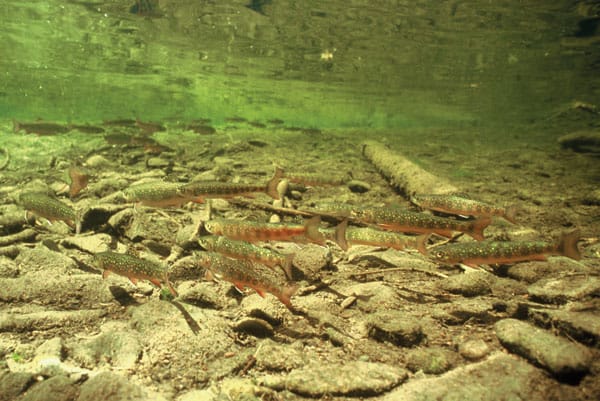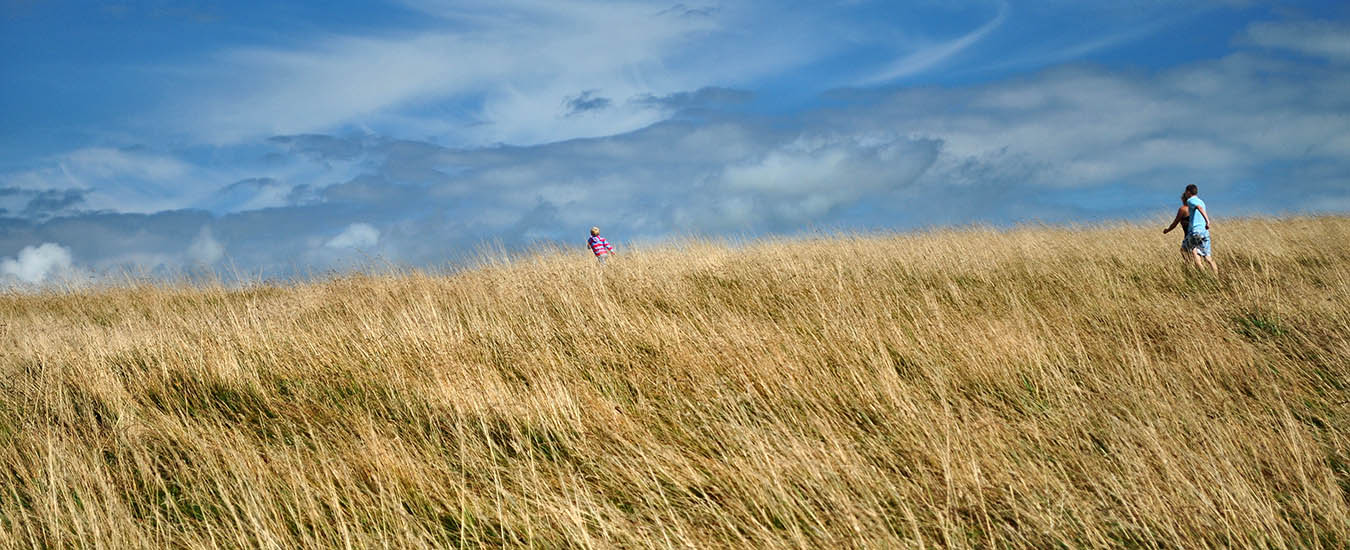Seriously impacted by human activity, our native speckled trout need a little help from their friends.
It’s a ritual. Whenever a field adventure in Eastern Canada leads me by a stream, I begin to ease quietly through the vegetation, searching for signs of life underwater.
The fish I hope to see are speckled trout (Salvelinus fontinalis). Both genders have a white leading edge on their side fins. Gold and black patterns wiggle over their mossy green backs, providing camouflage, so these otherwise vibrant fish become almost invisible when looked down upon in a sun-dappled stream. When peeking through rippled surface water, shadows moving over the bottom are sometimes easier to spot than the actual trout.
They are especially exquisite in autumn, when males sport vivid breeding colours. Their flanks already adorned with red spots circled by blue halos, males will occasionally flash their sides and bellies layered with hues of white, orange and brilliant red as they turn to feed, spar with other males for the best space in the pool, or attempt to entice a female to spawn.
My earliest, blurry memory is of a live fish that my parents held me up to see, and my initial fascination has lasted a lifetime. As a youngster, I kept nature records, caught and kept wild fish as pets and fed a growing interest in trout behaviour by gingerly dropping worms and bugs into pools that I never fished, preferring to watch.
Technically, speckled trout are not a trout, but a member of the char family. The commonly used term brook trout is also a misnomer. Sure, they are found in brooks and streams, but they inhabit beaver ponds, lakes and rivers of all sizes. Speckled trout are also found in estuaries and bays along Atlantic coastlines. They share some Maritime waters with imported, hatchery-reared Western Canadian rainbow trout, and naturalized European brown trout. Saltwater habitats are seasonal lifestyle choices for some members of all three species (seatrout).

Traditionally the most popular freshwater fish for anglers in Atlantic Canada, speckled trout gradually became my favourite fish. Fortunately there are still healthy speckled trout populations in some streams and lakes of Eastern Canada.
Historically, speckled trout ranged across the eastern half of Canada, Minnesota, Wisconsin and through New England southward along the high streams of the Appalachian Mountains to northern Georgia.
In fresh water, speckled trout prefer cold (12 to 15°C), clean, clear water that holds plenty of oxygen. Warm water holds less oxygen, and becomes lethal to trout when temperatures approach 25°C. Trout seek cold water refuges for the summer, about the time when humans are turning on their air conditioning.
Like most fish, trout are equipped with a series of small holes in the fine scales along their sides. These lateral lines sense pressure differences in the water made by sound or movement. They enable the fish to detect the shape and direction of the disturbance; thus they can avoid intruders, locate food and maintain a position underwater.
Trout also have overlapping sight that enables them to sense distance both in and above the water. They have nostrils to smell underwater and ears to help maintain an acute awareness of their watery world.
In streams and shallow rivers, speckled trout hide under fallen tree trunks, roots and undercut banks in pools for protection from predators like ospreys, kingfishers, mergansers, bald eagles, owls, great blue herons, mink, otters and even red foxes.
Floodwater, plunging over trees that have fallen across the stream, will scour the bottom to create and maintain deep, protective pools. Riffles with fast- flowing, shallow water over cobble, stone or gravel bottoms have hiding spaces that produce many blackfly larvae, caddis and stone fly nymphs. When dislodged, they drift downstream into pools where they frequently become trout food. Travelling up or downstream through shallow riffles begins as twilight descends, ending shortly after sunrise in an effort to avoid predators.
Speckled trout gather in social groups each autumn. Eventually they swim up rivers and streams to lay and fertilize eggs in clean gravel bottom sites called redds. Here water currents gently percolate through the gravel over the winter to keep the eggs alive. The young, called alevins, hatch in late winter or early spring. They absorb a yolk sac full of nutrients before struggling out of the gravel on to the bottom as “fry,” where they feed on plankton, insect larvae and nymphs.
By the time they reach a length of five to eight centimetres they are called fingerlings, and develop an appetite for mayflies, worms, insects, tiny mussels and snails. As they continue to grow, many speckled trout descend smaller streams to bigger water. Where streams empty into lakes, young trout are often forced to run a gauntlet through a waiting throng of mercenaries—a school of perch intent upon making a meal out of them.
In the Maritimes, speckled trout may live for five or six years. Exceptional sea-run specimens can attain a length of 68 centimetres and a weight of 3.5 kilograms. In Newfoundland and farther north where summers are shorter, growth rates are slower—and these fish may live longer.
The last bastions of speckled trout populations now remain in watersheds that still have undeveloped wilderness. Labrador and Northern Quebec still retain the largest brook trout in the world, reaching weights of more than four kilograms.
Human development activities, such as straightening rivers and streams into ditches for agricultural drainage, have left speckled trout severely challenged. Deep, cold water refuges have been degraded into wide, shallow, warm water zones where trout cannot survive. Too many forestry contractors have transformed cool streams into silty, flushing moonscapes, with apparent impunity from laws.
The favouring of trout by anglers offers advantage to competitive species in lakes. Cultural tradition has bass fishermen releasing their non-native catch, while a trout angler returning a good-eating trout to the water is considered a nerd.
The fish ladders on dams and culverts rarely permit ready passage up and down stream, while pollution inflicts heavy metals, acid rain, road salt and hormonal changes. Illegally introduced trout predators, such as smallmouth bass, muskellunge and chain pickerel, are challenging the speckled trout’s existence in many watersheds, while urban sprawl continues to spread its road-based tentacles into remaining wilderness.
This dire situation is improving in some places, though. Good science regarding the maintenance and restoration of cold water habitats that salmon and trout require already exists. It is being vigorously applied by associations, fish and game groups and federations in all four Atlantic provinces with the enthusiastic help of provincial governments and the muted assistance of the federal Department of Fisheries and Oceans.
There are many ways each one of us can help. (We need clean, cool water too.) Speckled trout could really use more human allies.
